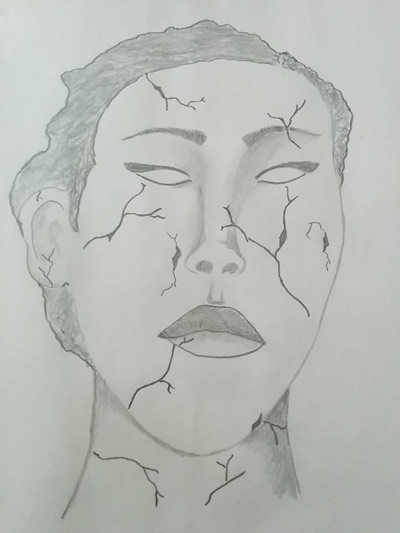 Josephine Fosuwaa drew this image of a cold, empty-eyed face during a time when she had given up on life (Photo: Josephine Fosuwaa)
Josephine Fosuwaa drew this image of a cold, empty-eyed face during a time when she had given up on life (Photo: Josephine Fosuwaa)
Josephine Fosuwaa doesn't remember her first visit to SickKids. Nor does she remember the first signs she had Sickle Cell Disease, a red blood cell disorder.
What she does remember is spending a large part of her childhood in and out of hospital and undergoing two liver transplants all before age 20.
Now 25, Fosuwaa's health is relatively stable and she is looking forward to finally attending nursing school next year.
"I have my down days," Fosuwaa said. "Walking can be a chore and right now I can't work or go to school, but I try to stay focused on the positive things in my life."
Josephine isn't alone.
Many people with a red blood cell disorder like Sickle Cell Disease have symptoms ranging from severe chronic pain to fatigue, jaundice and slower growth development.
Patients with red blood cell disorders are frequently in hospital for clinic appointments, in-patient treatments, urgent pain management or other emergencies such as infection.
'Pain crisis'
Josephine experiences excruciating pain when the tissues of her body do not receive a normal amount of blood. She has been in Toronto General Hospital's emergency room five times for pain crises since January 2014.
"The pain I experience when I am having a crisis is hard to describe," said Josephine. "It feels like being stabbed over and over, or having a pile of needles thrown on top of you while suffocating. It's an excruciating personal attack which you have little control of."
Feeling hopeless
Heather Gordon is a social worker in the Red Blood Cell Disorders Program at Toronto General Hospital.
Gordon provides psycho-social assessment, crisis management and treatment, connecting patients with essential community resources in order to minimize need for frequent hospital visits.
More often than not, Gordon's patients express feelings of stress, depression and hopelessness as a result of their disease.
"The life expectancy of red blood cell disorder patients is 20 to 30 years less than the average person," said Gordon. "Some experience excruciating pain daily and in some cases they feel like there is no one who understands their experience."
The only way to prevent pain crises is to stay hydrated and calm, take prescribed medications and reduce stress level whenever possible. Once a pain crises hits, the last resort for patients is to visit the emergency room. In some cases, Sickle Cell patients can visit the emergency room multiple times per month.
 Heather Gordon and Joseph Kalath partnered with their patients to create the first Red Blood Cell Patient Forum. (Photo: UHN Photographics)
Heather Gordon and Joseph Kalath partnered with their patients to create the first Red Blood Cell Patient Forum. (Photo: UHN Photographics)
Empowering patients to support each other
Noticing that there was a need for greater patient support, education and pain crises prevention, Gordon and her colleague Joseph Kalath from the Emergency Department partnered with patients for the first Red Blood Cell Patient Forum.
It was a seven month program culminating in a one-day event which demonstrated patient knowledge, skills, talents, leadership and peer to peer support.
UHN's Dr. Pendergrast and Dr. Kuo also lent their expertise by presenting at the forum on topics relating to their disease.
Josephine, a budding artist, created a session discussing the importance of positive reflections and images.
"The forum gave me something to work on and a sense of purpose," said Fosuwaa. "I also learned more about my disease and what other people have gone through."
In Canada, over 4,000 people live with a red blood cell disorder. Gordon believes as this number continues to grow, health care workers will need to get creative on how patients can support each other through their experience.
"We are working on another forum for next year," said Gordon. "Our patients are so excited about it."
Toronto General Hospital has one of the only Comprehensive Red Blood Cell Disorders Program for adults in Canada.
For Staff:
To find out more information about the clinic via the Intranet, click
here.
